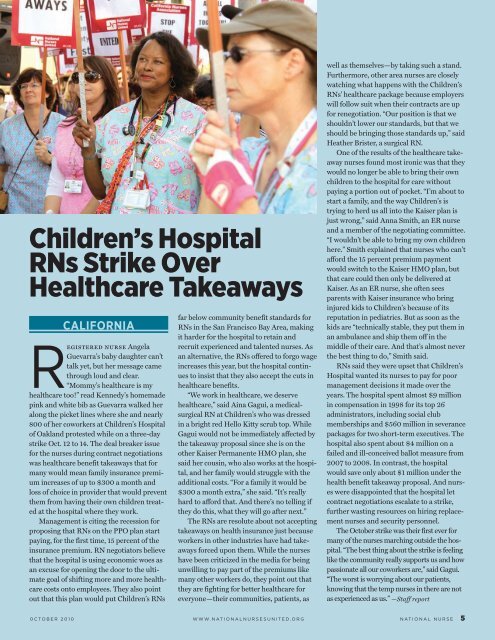National NURSE
National NURSE
National NURSE
You also want an ePaper? Increase the reach of your titles
YUMPU automatically turns print PDFs into web optimized ePapers that Google loves.
Children’s Hospital<br />
RNs Strike Over<br />
Healthcare Takeaways<br />
CALIFORNIA<br />
Registered nurse Angela<br />
Guevarra’s baby daughter can’t<br />
talk yet, but her message came<br />
through loud and clear.<br />
“Mommy’s healthcare is my<br />
healthcare too!” read Kennedy’s homemade<br />
pink and white bib as Guevarra walked her<br />
along the picket lines where she and nearly<br />
800 of her coworkers at Children’s Hospital<br />
of Oakland protested while on a three-day<br />
strike Oct. 12 to 14. The deal breaker issue<br />
for the nurses during contract negotiations<br />
was healthcare benefit takeaways that for<br />
many would mean family insurance premium<br />
increases of up to $300 a month and<br />
loss of choice in provider that would prevent<br />
them from having their own children treated<br />
at the hospital where they work.<br />
Management is citing the recession for<br />
proposing that RNs on the PPO plan start<br />
paying, for the first time, 15 percent of the<br />
insurance premium. RN negotiators believe<br />
that the hospital is using economic woes as<br />
an excuse for opening the door to the ultimate<br />
goal of shifting more and more healthcare<br />
costs onto employees. They also point<br />
out that this plan would put Children’s RNs<br />
far below community benefit standards for<br />
RNs in the San Francisco Bay Area, making<br />
it harder for the hospital to retain and<br />
recruit experienced and talented nurses. As<br />
an alternative, the RNs offered to forgo wage<br />
increases this year, but the hospital continues<br />
to insist that they also accept the cuts in<br />
healthcare benefits.<br />
“We work in healthcare, we deserve<br />
healthcare,” said Aina Gagui, a medicalsurgical<br />
RN at Children’s who was dressed<br />
in a bright red Hello Kitty scrub top. While<br />
Gagui would not be immediately affected by<br />
the takeaway proposal since she is on the<br />
other Kaiser Permanente HMO plan, she<br />
said her cousin, who also works at the hospital,<br />
and her family would struggle with the<br />
additional costs. “For a family it would be<br />
$300 a month extra,” she said. “It’s really<br />
hard to afford that. And there’s no telling if<br />
they do this, what they will go after next.”<br />
The RNs are resolute about not accepting<br />
takeaways on health insurance just because<br />
workers in other industries have had takeaways<br />
forced upon them. While the nurses<br />
have been criticized in the media for being<br />
unwilling to pay part of the premiums like<br />
many other workers do, they point out that<br />
they are fighting for better healthcare for<br />
everyone—their communities, patients, as<br />
well as themselves—by taking such a stand.<br />
Furthermore, other area nurses are closely<br />
watching what happens with the Children’s<br />
RNs’ healthcare package because employers<br />
will follow suit when their contracts are up<br />
for renegotiation. “Our position is that we<br />
shouldn’t lower our standards, but that we<br />
should be bringing those standards up,” said<br />
Heather Brister, a surgical RN.<br />
One of the results of the healthcare takeaway<br />
nurses found most ironic was that they<br />
would no longer be able to bring their own<br />
children to the hospital for care without<br />
paying a portion out of pocket. “I’m about to<br />
start a family, and the way Children’s is<br />
trying to herd us all into the Kaiser plan is<br />
just wrong,” said Anna Smith, an ER nurse<br />
and a member of the negotiating committee.<br />
“I wouldn’t be able to bring my own children<br />
here.” Smith explained that nurses who can’t<br />
afford the 15 percent premium payment<br />
would switch to the Kaiser HMO plan, but<br />
that care could then only be delivered at<br />
Kaiser. As an ER nurse, she often sees<br />
parents with Kaiser insurance who bring<br />
injured kids to Children’s because of its<br />
reputation in pediatrics. But as soon as the<br />
kids are “technically stable, they put them in<br />
an ambulance and ship them off in the<br />
middle of their care. And that’s almost never<br />
the best thing to do,” Smith said.<br />
RNs said they were upset that Children’s<br />
Hospital wanted its nurses to pay for poor<br />
management decisions it made over the<br />
years. The hospital spent almost $9 million<br />
in compensation in 1998 for its top 26<br />
administrators, including social club<br />
memberships and $560 million in severance<br />
packages for two short-term executives. The<br />
hospital also spent about $4 million on a<br />
failed and ill-conceived ballot measure from<br />
2007 to 2008. In contrast, the hospital<br />
would save only about $1 million under the<br />
health benefit takeaway proposal. And nurses<br />
were disappointed that the hospital let<br />
contract negotiations escalate to a strike,<br />
further wasting resources on hiring replacement<br />
nurses and security personnel.<br />
The October strike was their first ever for<br />
many of the nurses marching outside the hos -<br />
pital. “The best thing about the strike is feeling<br />
like the community really supports us and how<br />
passionate all our coworkers are,” said Gagui.<br />
“The worst is worrying about our patients,<br />
knowing that the temp nurses in there are not<br />
as experienced as us.” —Staff report<br />
0CTOBER 2010 WWW.NATIONAL<strong>NURSE</strong>SUNITED.ORG NATIONAL <strong>NURSE</strong> 5


